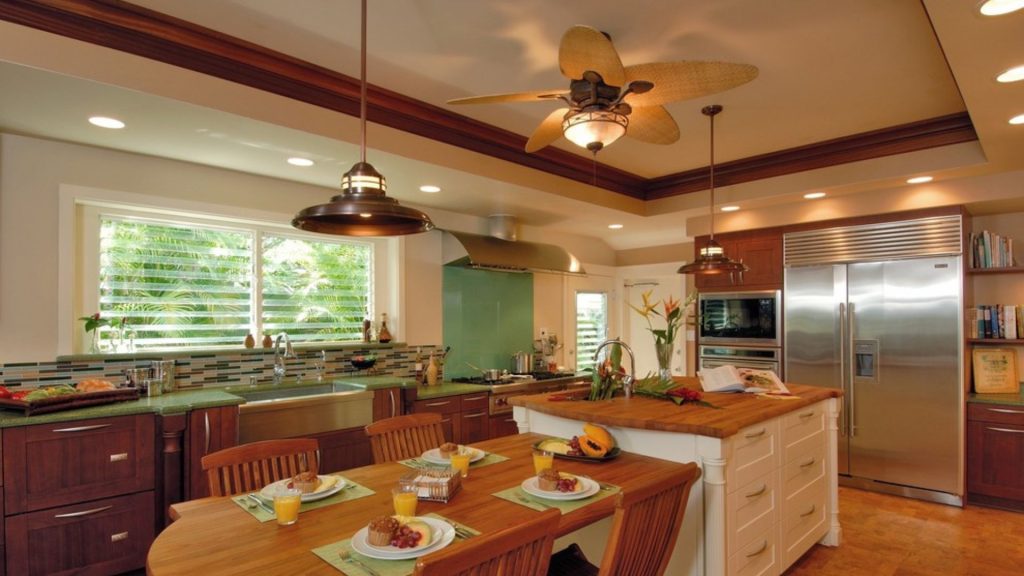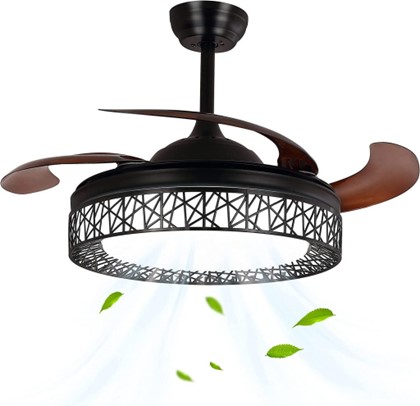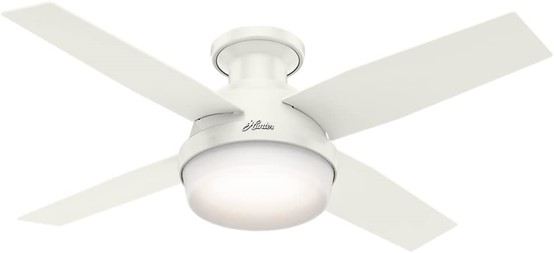
During the sweltering summer months, ceiling fans in the kitchen may be a lifesaver. With so much time spent in the kitchen and at the table, a ceiling fan is a must.
Is it a good idea to install a ceiling fan in your kitchen if you want to improve its aesthetics and ventilation.
Adding a ceiling fan to your kitchen is a terrific idea with many benefits whether you have poor ventilation or if you just want more airflow for a pleasant breeze, but there are a few things you need to consider first, such as the amount of available space, the amount of noise, and the aesthetics of the room.
Whether or not a ceiling fan is the right choice for you depends on a number of factors, so it’s crucial to do some research before making the purchase. The rest of this piece will explain why you should get a kitchen ceiling fan and what features to look for.
This article will tell you why putting a ceiling fan in your kitchen or dining room is a good idea.
Also Read: How Many Blades Should a Ceiling Fan Have
What does a ceiling fan do in the kitchen?
Improves ventilation in the cooking area
Fan blades mounted on the ceiling of a kitchen are used to improve airflow. They achieve this by preventing hot air from collecting in certain rooms and distributing it evenly throughout the house (like kitchens). Additionally, this will stop mold from forming on surfaces, which may lead to allergies and other health issues for you and your loved ones if not addressed.
Helps keep the kitchen mold-free
Having an electric ceiling fan in the kitchen also helps prevent the spread of mold.
Condensation no longer accumulates on the walls and floor due to the enhanced air flow.
Mold can develop on unclean surfaces and become a health hazard, especially in the kitchen, where it must be removed before using.
Get healthier in every way
Having a ceiling fan on helps to circulate the air in the room, which in turn helps to keep the air in the room clean and healthy.
Additionally, the moving blades help minimize allergens like dust mites, pet dander, and pollen floating about the room.
These advantages make utilizing a ceiling fan in the kitchen or living room an excellent way to reduce the tension that builds up during routine indoor tasks like meal preparation and cleanup.
Valuation Based on Appearance
With a ceiling fan, you may give your kitchen a one-of-a-kind look.
You may utilize it to add aesthetic value to your kitchen and make it consistent with the rest of your equipment and décor.
A ceiling fan installed in a white kitchen with light blue accents, for instance, would provide color to the room while also complementing the cabinets and counters.
Reduced Energy Use
Each month, the average American household consumes three thousand kilowatt hours (kWh) of power. A ceiling fan in the kitchen might cut this consumption by as much as half.
Putting in a new air conditioner will run you roughly $4,500 on average. Because of this, you may save hundreds, if not thousands, of dollars over the course of your system’s lifespan by installing an energy-efficient ceiling fan.
Key considerations for kitchen ceiling fan
You need a ceiling fan that can withstand a damp or wet environment, so check the UL ratings before buying.
It is imperative to use a ceiling fan that has been approved for use in a wet environment by UL (Underwriters’ Laboratories) when putting it in a kitchen. This implies that the device is impervious to water and other hazards commonly present in kitchens.
It’s important to pick a fan that’s the proper size for your room
The number and size of the ceiling lights in a space will determine the appropriate size of the fan to be employed. The size of the room determines the size of the ceiling fan. The size of the fan required is also influenced by the total number of lights.
If you want to install a ceiling fan in your kitchen and already have four lights, you’ll need a 10-inch model rather than an 8- or 9-inch one. If you want a clearer picture, learn more about ceiling fan dimensions.
Also Read: How to Choose the Right Size Ceiling Fan
Selecting the Proper Ceiling Fan Style (modern, contemporary, traditional)
Any kitchen may benefit from the addition of a ceiling fan, but it’s important to pick one that fits your decor.
Because of the prevalence of glass in today’s kitchens, ventilation fans need to be compact and inconspicuous. A fan that doubles as an overhead light is a must in conventional kitchens.
A ceiling fan in a modern design, with exposed blades or a sleek black finish, can help you achieve this appearance. Try a brass or brushed nickel finish, both of which are classic options, in a kitchen with classical elements.
Having a light kit available for the kitchen ceiling fan.
This is an essential function if you need to illuminate a huge space. It doesn’t matter where you put a ceiling fan as long as there’s room for the light kit.
Having a handheld device to adjust the pace and illumination is a huge convenience.
Possessing a remote for your kitchen ceiling fan that allows you to adjust the speed and on/off illumination is a great notion. You may customize the pace to meet the needs of your household, and it can also be used to regulate the illumination in your kitchen.
In addition to turning the fan on and off, the remote also lets you adjust the speed. The freedom from needing to be in close proximity to a wall switch or outlet makes this a fantastic appliance to have around the house.
Also Read: How To Wire Ceiling Fan With Light Easily
Four Unique Designs for a Kitchen Ceiling Fan Ideas
A crystal ceiling fan is essential in a high-end cooking space.

Simply installing a crystal ceiling fan in your kitchen is a great way to give a touch of class and style. You can use the light from these fans in a variety of ways; for instance, you may set them up above countertops or tables to create a more open feel and to have an extra source of light on hand. There is no need for wiring when you hang them from the ceiling independently.
Ceiling fans with chandelier lighting are frequently used in contemporary kitchens.

Adding a chandelier ceiling fan to your kitchen is a great way to make a statement with your home’s design. A chandelier is an exceptional choice for a decorative lighting fixture because of its one-of-a-kind style.
When shopping for this sort of fixture, you have a few design options; some versions use energy-efficient LED lights, while others use more conventional Edison bulbs.
Compact ceiling fan with four blades; ideal for kitchens with limited ceiling height

This ceiling fan is ideal for use in the kitchen. Its 56-inch width is exactly right for the area you have available without being too narrow. White’s neutrality makes it easy to match it with existing furnishings and accessories, while also injecting some much-needed vibrancy into an otherwise boring room.
A beautiful copper ceiling fan with lights, perfect for a modern home’s cooking space.

The kitchen copper ceiling fan is an excellent choice. It comes in a wide variety of shapes and colors, so you can find one that complements your kitchen’s aesthetic.
Brushed nickel, chrome, and satin nickel are just some of the various options for the fan’s finish. They’re cheap to run and simple to set up, requiring only a two-screw electrical box (or four-screw kit, if you want additinal lights) on the rear.
How often should I clean a kitchen ceiling fan?
Depending on how often you use it, your kitsch ceiling fan should be cleaned on a regular basis. If you only use the fan a few times a year, you can probably skip cleaning it altogether. If you use your fan often, however, once every couple of weeks should be plenty for routine maintenance.
You may also use a damp dustcloth or mop to clean your retro ceiling fan, but be sure to use warm water and a gentle soap.
Explain the function of an exhaust fan installed in a kitchen ceiling.
The same principles that apply to other types of fans also apply to kitchen ceiling extractor fans. Because the fan blows air upwards, it may be used to remove unwanted warmth from the kitchen.
What’s most essential to remember is that these fans are meant for the kitchen and not the bathroom, so you shouldn’t put them there.
Also Read: Fan Rotates In Which Direction?
There are benefits and drawbacks to installing a ceiling fan in the kitchen.
Benefits of installing a ceiling fan in the kitchen
It improve ventilation.
That’s the intended purpose of fans, after all.
The good news is that kitchen ceiling fans are wonderful for getting rid of lingering food scents long after cooking is done. Better ventilation is helpful in case you (no judgment here) light up while cooking, and the smoke fills the room.
If you spend a lot of time in the kitchen baking, the stale, stuffy air may be a real pain to deal with, but a ceiling fan can help circulate the air and reduce the musty odors.
The combination of a few strategically opened windows and a ceiling fan may do wonders for the ventilation in your kitchen.
The Cost of Energy, Reduced
Installing a ceiling fan in the kitchen can help you save up to 30 percent on your energy cost during the warm summer months. In reality, ceiling fans are an excellent eco-friendly option for reducing one’s energy use.
When the temperature rises, turning on the air conditioner may quickly increase your electricity bill, but if a fan can help you feel more comfortable in the same environment, you can save money by turning it off less often.
If you live in a warmer region and rely on air conditioning frequently to keep you comfortable, you may notice a good decline in your energy cost after operating your kitchen ceiling fan for some time.
Remember that ceiling fans don’t really cool the air, they only spread it across the room, so the wind-chill effect won’t be as effective if you live in a humid climate, but it will still be better than without a fan.
To Prevent Insects
When you’re cooking, you could get bothered by a variety of flying pests if you have the habit of leaving a window propped open or a screen door pulled open. A ceiling fan in the kitchen may be a useful tool in the fight against these troublesome insects.
Even though mosquitoes aren’t the best fliers, they can be kept at bay by turning on the fan in the kitchen; they can’t handle the extra airflow. Are ceiling fans effective in reducing mosquito populations?
While a fast-moving ceiling fan won’t prevent insects from entering the house in the first place, it will at least deter them from bothering you while you cook.
Also Read: How much does it cost to run a ceiling fan
There Are Drawbacks to Using a Kitchen Ceiling Fan
There are pros and drawbacks to installing a ceiling fan in your kitchen, such as the benefits of increased ventilation, reduced temperature, and reduced insect infestation.
Ceiling fans in the kitchen are often unsightly.
Perhaps the most challenging aspect of putting up a kitchen ceiling fan is deciding where to put it and how it will appear once you’re done.
If you’re not good at making decisions, finding kitchen appliances of the proper color, style, and form might be a headache.
You can discover the appropriate fan for your kitchen even if many of them are more suited to the cozier tones of a living room than the neat and orderly atmosphere of a kitchen.
Just be aware that it may take some time to zero down on the specific kind of fan that is most suited to your needs.
Installing a ceiling fan in a kitchen might be a challenge.
Your kitchen’s electrical setup isn’t ideal for installing a fan, but that doesn’t mean it’s impossible. It will be necessary to run wires from the ceiling or the attic to provide the necessary electricity.
It’s best to have your local professional electricians handle the installation of these cables unless you have expertise as an electrician or are a DIY expert.
Using an open flame while the kitchen ceiling fan is running might be dangerous.
If your kitchen has a gas stove and you frequently turn on the ceiling fan, the movement of the flames might provide a fire threat.
Serving meals on the counter top causes the food to cool off more faster due to the above fan.
You can prevent this from happening by keeping the fan away from your cooktop and the dining table.
The Loudness May Surprise You
Fans on the ceiling aren’t particularly noisy, but in a cramped kitchen, even the slightest noise may be felt.
You’ll need a rather sizable fan that makes a lot of noise to adequately ventilate your kitchen.
A kitchen ceiling fan might not be the best choice if the continual swishing sound is going to drive you crazy.
Conclusion
A home with working ceiling fans in the kitchen is a quiet home. The low energy consumption of fans makes them a smart purchase for anybody concerned about their carbon footprint and monthly power bill.
The ventilation in your kitchen is especially vital if you have a lot of people working there at once; otherwise, everyone will get too hot and tired to accomplish their best. Using ceiling fans helps with this because they make sure that fresh air is always moving around the room. This keeps people from suffocating, having trouble breathing, or other problems that could happen if they were too close together.
About The Author
